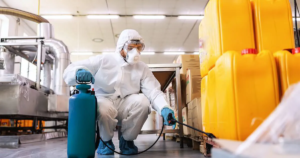Pest Control O’fallon MO is the process of managing pests to prevent them from damaging or harming humans, property, or the environment. This can be achieved through a number of methods such as baiting, trapping, spraying, and blocking access to food, water, shelter, or other resources.

Natural forces such as climate and natural enemies affect pest populations. Threshold levels, based on esthetic and health concerns, determine when action must be taken.
Accurate pest identification is the first step in any successful pest management program. Whether you are dealing with insects, diseases, weeds or vertebrate animals, different species have unique characteristics that influence their control. Treatment methods are most effective when they target the pest at a stage in their life cycle that is most susceptible to intervention. Pest identification also allows you to determine if poor plant growth or damage is due to environmental conditions rather than a particular pest.
The most common signs of a pest infestation are tracks or marks left by the pests themselves. These can be as simple as a trail of dirt from the cockroaches or mice running through your house, to more obvious markings on the leaves and stems of your plants. Unexplained health problems such as sneezing, itchy eyes or skin rashes may also be signs of a pest problem. Pests such as rodents, cockroaches and flies are known to cause allergies and asthma in people.
Other signs of a pest problem include finding their droppings or traces of their waste. These can be especially visible in pantries or other areas where they are likely to gather. Unusual odors from rotten food or from the decomposing bodies of the pests themselves may also indicate a pest infestation.
Many pests have specialized mouthparts to feed on specific parts of a plant, while others have generalized mouthparts to puncture or chew. As a result, their physical appearance can vary greatly at different stages in their lives or as a result of environmental conditions. This can make them difficult to identify without a close examination or the help of a pest identification guide.
There are many online and printed pest identification guides available for agricultural and horticultural producers. Many of these are maintained by universities or State department of agriculture or natural resources. In addition, the National Identification Services (NIS) provides accurate, nationwide identifications of plant pests for APHIS’s regulatory programs. NIS staff have expertise in the fields of botany, entomology, malacology and mycology and serve as the final taxonomic authority for plant pest identifications.
Prevention
Preventive pest control measures stop infestations before they occur, rather than reacting to an existing problem. Generally, this approach reduces the amount of pesticide used on a property as well as prevents harm to people, pets and plants. Regular inspections of a home or commercial facility can detect early signs of pests and prevent them from becoming a major issue. Typical preventive methods include sealing cracks and gaps where pests enter, maintaining sanitation practices to eliminate food sources, and removing conditions that attract pests (e.g., clutter and rotting wood).
Pest control may also involve the use of predators and parasites to kill or repel pests. These methods are referred to as biological control and can be very effective in some cases, especially when the appropriate species is released at the right time and place. Examples of biological control are the use of predatory wasps and bees to sting and kill fruit flies, and the introduction of nematodes to the soil that kill or damage pests, such as grubs and slugs.
Integrated Pest Management is an approach to pest control that looks at the bigger picture, including how a particular pest impacts its environment and how it fits into the natural ecosystem. This is important when evaluating a pest control strategy because eradicating pests without considering the effects on the habitat and other organisms may actually make the situation worse.
Implementing an effective prevention program can save a company money by preventing costly repairs and replacements caused by pests. It can also give a company peace of mind, knowing that pests are regularly being monitored and treated by professionals, preventing an infestation before it becomes a major problem. It can also help prevent damage to a building or its contents and preserve the value of a home or commercial property. Finally, pest control can protect people’s health and safety by eliminating pathogens and allergens that can be spread by certain pests, such as mosquitoes, cockroaches and rodents. In addition, a routine pest control program can also help to maintain a business’s or homeowner’s image by avoiding embarrassing pest-related public relations issues such as product recalls.
Suppression
Pest control involves taking steps to reduce a pest population to an acceptable level. This can be done through prevention, suppression or eradication. It is important to keep in mind that pest populations are influenced by many factors, including natural forces (climate, soil health and topography), natural enemies (predators, parasitoids and disease organisms) and cultural practices.
Preserve Your Home’s Value: Regular pest control can help prevent damage to your house, furniture, and belongings. This can save money on costly repairs and replacements.
Protect Your Family’s Health: Many pests carry harmful pathogens that can cause diseases. Routine pest control helps to minimize exposure to these pathogens and allergens.
A Safe Environment: Many pesticides can be harmful to children and pets. Keeping your home and property free of clutter can make it safer for everyone in the household. It is also important to wear personal protective equipment when handling pesticides, including long-sleeved shirts and pants, closed-toe shoes, and face and eye protection.
The Threshold Model: A threshold approach to pest management is an effective way to balance the needs of humans and ecosystems. It is based on the concept that a healthy urban ecosystem contains a diversity of species. A balanced mix of plants, insects, and other organisms competes for resources and prevents pest outbreaks. The goal is to achieve this natural balance through preventive and suppression methods rather than total eradication of pests.
Regulatory Control
Regulatory controls are generally employed to address large, widespread, or severe problems that affect human health and safety, agricultural crops or animals, or commercial properties. Regulatory controls include quarantine, eradication, and other enforcement measures. These measures are generally applied when preventive and other control methods have been unsuccessful in addressing the problem. Regulatory control can also help improve management practices to avoid future infestations. For example, regulatory controls may encourage more frequent inspections of commercial food preparation and hospitality environments to help identify potential problems before they become widespread. They can also help educate people on better sanitation and cleaning practices to minimize contamination of foods and materials that could harm human health.
Eradication
Biological control uses predators, parasitoids and disease organisms to reduce pest populations. These organisms usually are natural to the environment, and they occur in nature as part of the food chain. They typically have short life cycles and may only cause a few days of damage to their host before they move on to other prey. Examples include nematodes, mites, fleas and ticks.
Integrated pest management seeks to prevent or delay pest problems rather than controlling them after they occur. Practicing prevention and suppression methods regularly and quickly reduces the number of pests and their damage, depriving them of the opportunity to reproduce. When pest numbers reach damaging levels, eradication techniques can be used to destroy them.
Eradication is the ultimate goal of a pest control program. It requires that all preventive and suppression efforts be scaled up to the community, local, national or global level. It is an expensive undertaking, and it requires that a range of factors be in place to ensure success. For example, successful eradication of infectious diseases depends on being able to identify all potentially infected persons, interrupt microbe transmission and remove them from the population.
Achieving eradication for continuous pests like grasshoppers, mosquitoes and Japanese beetles can be very challenging. For these pests, there are few natural predators and parasitoids, and their populations tend to be concentrated. For instance, one lawn may have copious numbers of green June beetle grubs while another two doors down has almost none.
Biological control often involves waiting for natural enemies to appear, but this can be problematic when the pests are introduced into an area where they have few natural predators and parasitoids. Also, it can be difficult to predict the timing of introducing natural enemies, because they depend on weather conditions and other environmental factors.
The eradication of pests also depends on an estimated economic cost-benefit analysis, which determines whether the benefits of destroying the pest outweigh the costs of the eradication effort. This analysis compares the cost of eradicating the pest to the costs of future infections and vaccinations that would occur without eradication.

